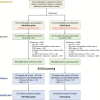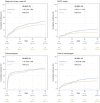Artificial Intelligence-Enabled ECGs for Atrial Fibrillation Identification and Enhanced Oral Anticoagulant Adoption: A Pragmatic Randomized Clinical Trial
- PMID: 40611485
- PMCID: PMC12533671
- DOI: 10.1161/JAHA.125.042106
Artificial Intelligence-Enabled ECGs for Atrial Fibrillation Identification and Enhanced Oral Anticoagulant Adoption: A Pragmatic Randomized Clinical Trial
Abstract
Background: Atrial fibrillation (AF) is often underdiagnosed and undertreated by noncardiologists. This study evaluated whether artificial intelligence-enabled ECG (AI-ECG) alerts could improve AF diagnosis and non-vitamin K antagonist oral anticoagulant prescriptions by noncardiologists.
Methods: In this open-label, cluster randomized controlled trial (NCT05127460) at 2 hospitals in Taiwan, noncardiologists were randomized to an intervention group (AI-ECG alerts) or control group (usual care). Alerts were sent to physicians when AI-ECG identified AF in emergency or hospitalized patients at risk of stroke (CHA₂DS₂-VASc ≥1 for men, ≥2 for women), excluding those with prior AF or oral anticoagulant use. Primary end points included a non-vitamin K antagonist oral anticoagulant prescription within 90 days after discharge, new AF diagnosis, echocardiogram arrangements, and cardiologist visits. Secondary end points were ischemic stroke, cardiovascular death, and all-cause death.
Results: A total of 8857 and 8960 patients were treated by 120 and 113 noncardiologists in the intervention and control groups, respectively; 275 and 245 patients had AI-detected AF. The non-vitamin K antagonist oral anticoagulant prescription rate was significantly higher in the intervention group (23.3% versus 12.0%; hazard ratio [HR], 1.85 [95% CI, 1.11-3.07]). The intervention group also had a higher rate of AF diagnosis (HR, 1.40 [95% CI, 1.03-1.90]). No significant differences were observed in echocardiogram arrangements, cardiologist visits, or the rates of ischemic stroke, cardiovascular death, and all-cause death.
Conclusions: An AI-ECG alert for AF identification promoted non-vitamin K antagonist oral anticoagulant prescriptions among noncardiologists, thus reducing the disparity in AF care quality between cardiologists and noncardiologists.
Registration: URL: https://clinicaltrials.gov/; Unique identifier: NCT05127460.
Keywords: ECG; artificial intelligence; atrial fibrillation; deep learning; ischemic stroke; non–vitamin K antagonist oral anticoagulants; randomized clinical trial.
Conflict of interest statement
None.
Figures




References
-
- Hindricks G, Potpara T, Dagres N, Arbelo E, Bax JJ, Blomström‐Lundqvist C, Boriani G, Castella M, Dan G‐A, Dilaveris PE, et al. 2020 ESC guidelines for the diagnosis and management of atrial fibrillation developed in collaboration with the European Association for Cardio‐Thoracic Surgery (EACTS): the task force for the diagnosis and management of atrial fibrillation of the European Society of Cardiology (ESC) developed with the special contribution of the European heart rhythm association (EHRA) of the ESC. Eur Heart J. 2020;42:373–498. doi: 10.1093/eurheartj/ehaa612 - DOI - PubMed
-
- Heidbuchel H, Dagres N, Antz M, Kuck K‐H, Lazure P, Murray S, Carrera C, Hindricks G, Vahanian A. Major knowledge gaps and system barriers to guideline implementation among European physicians treating patients with atrial fibrillation: a European Society of Cardiology international educational needs assessment. EP Europace. 2018;20:1919–1928. doi: 10.1093/europace/euy039 - DOI - PubMed
Publication types
MeSH terms
Substances
Associated data
LinkOut - more resources
Full Text Sources
Medical

